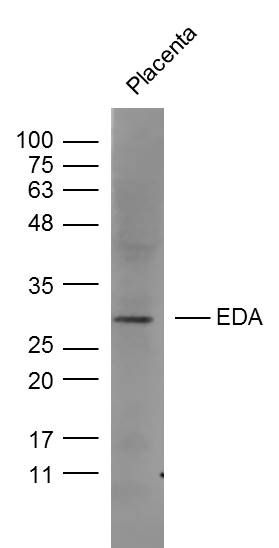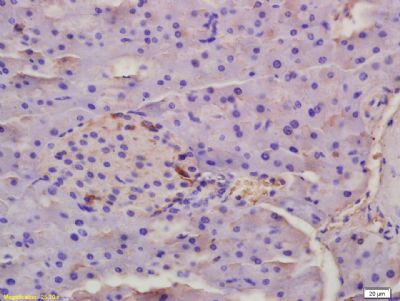产品中心
当前位置:首页>产品中心Anti-EDA
货号: bs-1149R 基本售价: 780.0 元 规格: 50ul
- 规格:50ul
- 价格:780.00元
- 规格:100ul
- 价格:1380.00元
- 规格:200ul
- 价格:2200.00元
产品信息
- 产品编号
- bs-1149R
- 英文名称
- EDA
- 中文名称
- 外胚层发育不良蛋白抗体
- 别 名
- Ectodysplasin-A; Ectodermal dysplasia 1, anhidrotic; Ectodermal dysplasia protein; Ectodermal dysplasia, anhidrotic (hypohydrotic); Ectodysplasin A; Ectodysplasin A, membrane form; Ectodysplasin A, secreted form; ECTODYSPLASIN A1 ISOFORM; ECTODYSPLASIN A2 ISOFORM; ECTODYSPLASIN; ED1 A1; ED1 A2; ED1; ED1 GENE; Eda A1; Eda A2; EDA protein; EDA_HUMAN; ODT1; Oligodontia 1; secreted form; STHAGX1; Ta; Tabby; Tabby protein; X linked anhidroitic ectodermal dysplasia protein; XHED; XLHED; EDA protein homolog; EDA1; EDA1 GENE; EDA2; HED; Ta; Tabby; Tabby protein; XHED; XLHED.
- 规格价格
- 50ul/780元购买 100ul/1380元购买 200ul/2200元购买 大包装/询价
- 说 明 书
- 50ul 100ul 200ul
- 研究领域
- 细胞生物 免疫学 信号转导
- 抗体来源
- Rabbit
- 克隆类型
- Polyclonal
- 交叉反应
- Human, Mouse, Rat, Pig, Cow, Horse,
- 产品应用
- WB=1:500-2000 ELISA=1:500-1000 IHC-P=1:400-800 IHC-F=1:400-800 ICC=1:100-500 IF=1:100-500 (石蜡切片需做抗原修复)
not yet tested in other applications.
optimal dilutions/concentrations should be determined by the end user.
- 分 子 量
- 24/41kDa
- 细胞定位
- 细胞膜 分泌型蛋白
- 性 状
- Lyophilized or Liquid
- 浓 度
- 1mg/ml
- 免 疫 原
- KLH conjugated synthetic peptide derived from human Ectodysplasin-A, secreted form:131-230/391 <Extracellular>
- 亚 型
- IgG
- 纯化方法
- affinity purified by Protein A
- 储 存 液
- 0.01M TBS(pH7.4) with 1% BSA, 0.03% Proclin300 and 50% Glycerol.
- 保存条件
- Store at -20 °C for one year. Avoid repeated freeze/thaw cycles. The lyophilized antibody is stable at room temperature for at least one month and for greater than a year when kept at -20°C. When reconstituted in sterile pH 7.4 0.01M PBS or diluent of antibody the antibody is stable for at least two weeks at 2-4 °C.
- PubMed
- PubMed
- 产品介绍
- background:
The protein encoded by the EDA gene is a type II membrane protein that can be cleaved by furin to produce a secreted form. The encoded protein, which belongs to the tumor necrosis factor family, acts as a homotrimer and may be involved in cell-cell signaling during the development of ectodermal organs. Defects in the EDA gene are a cause of ectodermal dysplasia, anhidrotic, (this is also known as X-linked hypohidrotic ectodermal dysplasia). Several transcript variants encoding many different isoforms have been found for this gene. AltName: ectodermal dysplasia protein; Ectodysplasin-A; EDA protein homolog; Tabby protein; Ectodysplasin-A, membrane form; secreted form EDA-A5.
Function:
Seems to be involved in epithelial-mesenchymal signaling during morphogenesis of ectodermal organs. Isoform 1 binds only to the receptor EDAR, while isoform 3 binds exclusively to the receptor XEDAR.
Subunit:
Homotrimer. The homotrimers may then dimerize and form higher-order oligomers.
Subcellular Location:
Cell membrane; Single-pass type II membrane protein.
Ectodysplasin-A, secreted form: Secreted.
Tissue Specificity:
Not abundant; expressed in specific cell types of ectodermal (but not mesodermal) origin of keratinocytes, hair follicles, sweat glands. Also in adult heart, liver, muscle, pancreas, prostate, fetal liver, uterus, small intestine and umbilical chord.
Post-translational modifications:
N-glycosylated.
Processing by furin produces a secreted form.
DISEASE:
Ectodermal dysplasia 1, hypohidrotic, X-linked (XHED) [MIM:305100]: A form of ectodermal dysplasia, a heterogeneous group of disorders due to abnormal development of two or more ectodermal structures. Characterized by sparse hair (atrichosis or hypotrichosis), abnormal or missing teeth and the inability to sweat due to the absence of sweat glands. It is the most common form of over 150 clinically distinct ectodermal dysplasias. Note=The disease is caused by mutations affecting the gene represented in this entry.
Tooth agenesis selective X-linked 1 (STHAGX1) [MIM:313500]: A form of selective tooth agenesis, a common anomaly characterized by the congenital absence of one or more teeth. Selective tooth agenesis without associated systemic disorders has sometimes been divided into 2 types: oligodontia, defined as agenesis of 6 or more permanent teeth, and hypodontia, defined as agenesis of less than 6 teeth. The number in both cases does not include absence of third molars (wisdom teeth). Note=The disease is caused by mutations affecting the gene represented in this entry.
Similarity:
Belongs to the tumor necrosis factor family.
Contains 1 collagen-like domain.
SWISS:
Q92838
Gene ID:
1896
Database links:Entrez Gene: 1896 Human
Entrez Gene: 13607 Mouse
Entrez Gene: 302424 Rat
Omim: 300451 Human
SwissProt: Q92838 Human
SwissProt: O54693 Mouse
Unigene: 105407 Human
Unigene: 328086 Mouse
Unigene: 211298 Rat
Important Note:
This product as supplied is intended for research use only, not for use in human, therapeutic or diagnostic applications.
Ectodermal dysplasia 1属于TNF家族成员,为常染色体隐性遗传病。
- 产品图片
 Sample:
Sample:
Placenta (Mouse) Lysate at 40 ug
Primary: Anti-EDA (bs-1149R) at 1/300 dilution
Secondary: IRDye800CW Goat Anti-Rabbit IgG at 1/20000 dilution
Predicted band size: 24/41 kD
Observed band size: 30 kD Tissue/cell: rat placenta tissue; 4% Paraformaldehyde-fixed and paraffin-embedded;
Tissue/cell: rat placenta tissue; 4% Paraformaldehyde-fixed and paraffin-embedded;
Antigen retrieval: citrate buffer ( 0.01M, pH 6.0 ), Boiling bathing for 15min; Block endogenous peroxidase by 3% Hydrogen peroxide for 30min; Blocking buffer (normal goat serum,C-0005) at 37℃ for 20 min;
Incubation: Anti-ED-1 Polyclonal Antibody, Unconjugated(bs-1149R) 1:200, overnight at 4°C, followed by conjugation to the secondary antibody(SP-0023) and DAB(C-0010) staining

